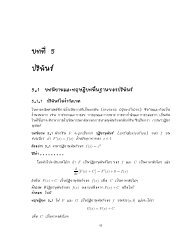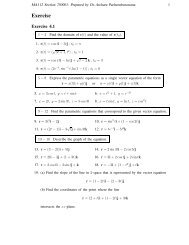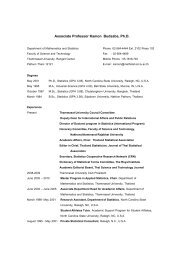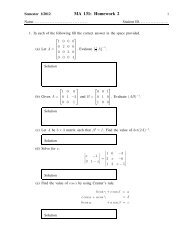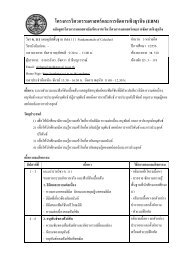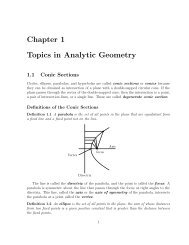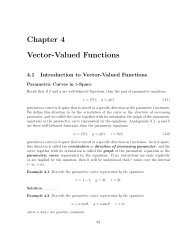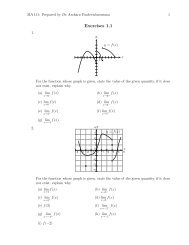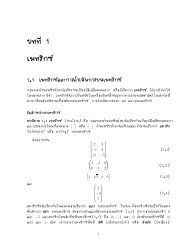Chapter 1 Topics in Analytic Geometry
Chapter 1 Topics in Analytic Geometry
Chapter 1 Topics in Analytic Geometry
You also want an ePaper? Increase the reach of your titles
YUMPU automatically turns print PDFs into web optimized ePapers that Google loves.
•MA112 Section 750001: Prepared by Dr.Archara Pacheenburawana 65Example 4.5 Describe the graph of the vector-valued functionSolution .........r(t) = 〈cost,s<strong>in</strong>t,t〉 = costi+s<strong>in</strong>tj+tkIf a parametric curve is viewed as the graph of a vector-valued function, then we canalso imag<strong>in</strong>e the graph to be traced by the tip of the mov<strong>in</strong>g vector. For example, if thecurve C <strong>in</strong> 3-space is the graph ofr(t) = x(t)i+y(t)j+z(t)kand if we position r(t) so its <strong>in</strong>itial po<strong>in</strong>t is at the orig<strong>in</strong>, then its term<strong>in</strong>al po<strong>in</strong>t will fallon the curve C.z(x(t),y(t),z(t))r(t)CyxThus, when r(t) is positioned with its <strong>in</strong>itial po<strong>in</strong>t at the orig<strong>in</strong>, its term<strong>in</strong>al po<strong>in</strong>t will traceout the curve C as the parameter t varies, <strong>in</strong> which case we call r(t) the radius vector orthe position vector for C.Example 4.6 Sketch the graph and a radius vector of(a) r(t) = costi+s<strong>in</strong>tj, 0 ≤ t ≤ 2π(b) r(t) = costi+s<strong>in</strong>tj+2k, 0 ≤ t ≤ 2πSolution .........Vector Form of a L<strong>in</strong>e SegmentRecall that if r 0 is a vector <strong>in</strong> 2-space or 3-space with its <strong>in</strong>itial po<strong>in</strong>ts at the orig<strong>in</strong>, thenthe l<strong>in</strong>e that passes through the term<strong>in</strong>al po<strong>in</strong>t of r 0 and is parallel to the vector v can beexpressed <strong>in</strong> vector form asr = r 0 +tvIn particular, if r 0 and r 1 are vectors <strong>in</strong> 2-space or 3-space with their <strong>in</strong>itial po<strong>in</strong>ts atthe orig<strong>in</strong>, then the l<strong>in</strong>e that passes through the term<strong>in</strong>al po<strong>in</strong>ts of these vectors can beexpressed <strong>in</strong> vector form asr = r 0 +t(r 1 −r 0 ) or r = (1−t)r 0 +tr 1 (4.5)



